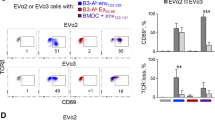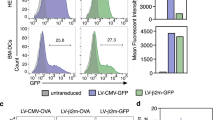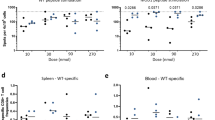Abstract
Nucleic acid immunization is a novel vaccination technique to induce antigen-specific immune responses. We have developed expression cassettes for cell surface markers CD80 and CD86, two functionally related costimulatory molecules that play an important role in the induction of T cell-mediated immune responses. Coimmunization of these expression plasmids, along with plasmid DNA encoding for HIV-1 antigens, did not result in any significant change in the humoral response; however, we observed a dramatic increase in cytotoxic T-lymphocyte (CTL) induction as well as T-helper cell proliferation after the coadministration of CD86 genes, in contrast, coimmunization with a CD80 expression cassette resulted in a minor, but positive increase in T-helper cell or CTL responses. This strategy may be of value for the generation of rationally designed vaccines and immune therapeutics.
This is a preview of subscription content, access via your institution
Access options
Subscribe to this journal
Receive 12 print issues and online access
$209.00 per year
only $17.42 per issue
Buy this article
- Purchase on Springer Link
- Instant access to full article PDF
Prices may be subject to local taxes which are calculated during checkout
Similar content being viewed by others
References
Kim, J.J., Ayyvoo, V., Bagarazzi, M.L., Chattergoon, M.A., Dang, K., Wang, B. et al. 1997 In vivo engineering of a cellular immune response by coadministration of IL-12 expression vector with a DMA immunogen. J. Immunol. 158: 816–826.
Boyer, J.D., Wang, B., Ugen, K., Agadjanyan, M.G., Javadian, MA, Frost, R. et al. 1996 Protective anti-HIV immune responses in non-human primates through DMA immunization. J. Med. Primatol. 25: 242–250.
Wang, B., Ugen, K.E., Srikantan, V., Agadjanyan, M.G., Dang, K., Refaefi, Y. et al. 1993 Gene inoculation generates immune responses against human immunodeficiency virus type 1. Proc. Natl. Acad. Sci. USA 90: 4156–4160.
Wang, B., Boyer, J.D., Ugen, K.E., Srikantan, V., Ayyavoo, V., Agadjanyan, M.G. et al. 1995 Nucleic acid-based immunization against HIV-1: induction of protective in vivo immune responses. AIDS 9: S159–170.
Tang, D., DeVrt, M. and Johnston, S. 1992 Genetic immunization is a simple method for elicting an immune response. Nature 356: 152–154.
Utmer, J., Donneily, J., Parker, S.E., Rhodes, G.H., Feigner, P.L., Dwarki, V.L. et al. 1993 Heterologous protection against influenza by injection of DMA encoding a viral protein. Science 259: 1745–1749.
Davis, H., Michel, M.L. and Whalen, R.G. 1993 DMA-based immunization induces continuous secretion of hepatitis B surface antigen and high levels of circulating antibody. Human Mol. Genetics 2: 1857–1851.
Fynan, E., Webster, R., Fuller, D., Haynes, J., Santoro, J. and Robinson, H. 1993 DMA vaccines: Protective immunizations by parenteral, mucosal, and gene-gun inoculations. Proc. Nati. Acad. Sci. USA 90: 11478–11482.
Margolis, H.S. 1993 Prevention of acute and chronic liver disease through immunization: hepatitis Band beyond. J.lnf.Dis. 168: 9–14.
Zarozinski, C.C., Fynan, E.F., Selin, L.K., Robinson, H.L. and Welsh, R.M. 1995 Protective CTL-dependent immunity and enhanced immunopathology in mice immunized by particle bombardment with DMA encoding an internal virion protein. J. Immunol. 154: 4010–4017.
Doe, B., Selby, M., Barnett, S., Baenzinger, J. and Walker, C.M. 1996 Induction of cytotoxic T-lymphocytes by intramuscular immunization with plasmid DMA is facilitated by bone marrow-derived cells. Proc. Natl. Acad. Sci. USA 93: 8578–8583.
Corr, M., Lee, D.J., Carson, D.A. and Tighe, H. 1996 Gene vaccination with naked plasmid DNA: mechanism of CTL priming. J. Exp. Med. 184: 1555–1560.
Pardoll, D.M. and Beckerteg, A.M. 1995 Exposing the immunology of naked DNA vaccines. Immunity 3: 165–169.
Brodsky, F.M. and Guagliardi, L.E. 1991 The cell biology of antigen processing and presentation. Ann. Rev. Immunol. 9: 707–744.
Wolff, J.A., Malone, R.W., Williams, R., Chong, W., Acsadi, G., Jani, A. and Feigner, P.L. 1990 Direct gene transfer into mouse muscle in vivo. Science 247: 1465–1468.
Beauchamp, J.R., Abraham, D.J., Bou-Gharios, G., Partridge, T.A. and Olsen, I. 1992 Expression and function of heterotypic adhesion molecules during differentiation of human skeletal muscle in culture. Am. J. Pathol. 140: 387–401.
Blau, H.M. and Webster, C. 1981 Isolation and characterization of human muscle cells. Proc. Nati. Acad. Sci. USA 78: 5623–5627.
Goebels, N., Michaelis, D., Wekerte, M. and Hohlfeld, R. 1992 Human myoblasts as antigen-presenting cells. J. Immunol. 148: 661–667.
Hohlfeld, R. and Engel, A.G. 1990 Induction of HLA-DR expression on human myoblasts with interferon-gamma. Am. J. Pathol. 136: 503–508.
Hohlfeld, R. and Engel, A.G. 1994 The immunobiology of muscle. Immunol. Today 15: 269–274.
Michaelis, D., Goebels, N. and Hohlfeld, R. 1993 Constitutive abd cytokine-induced expression of human leukocyte antigens and cell adhesion molecules by human myotubes. Am. J. Pathol. 143: 1142–1149.
Mantegazza, R., Hughes, S.M. Mitchell, D., Travis, M., Blau, H.M. and Steinman, L. 1991 Modulation of MHC class II antigen expression in human myoblasts after treatment with IFN-y. Neurol. 41: 1128–1132.
Roy, R., Dansereau, G. Tremblay, J.R., Belles-Isles, M., Huard, J., Labrecque, C. and Bouchard, J.R. 1991 Expression of major histocompatibility complex antigens on human myoblasts. Trans. Proceed. 23: 799–801.
June, C., Bluestone, J.A., Nadler, L.M. and Thompson, C.B. 1994 The B7 and CD28 receptor families. Immunol. Today 15: 321–333.
Lanier, L.L., O'Falton, S., Somoza, C., Phillips, J.H., Linsley, P.S., Okumura, K. et al. 1995 CD80 (B7) and CD86 (B70) provide similar costimulatory signals for T-cell proliferation, cytokine production, and generation of CTL. J. Immunol. 154: 97–105.
Linsley, P.S., Clark, E.A. and Ledbetter, J.A. 1990 The T-cell antigen, CD28, mediates adhesion with B cells by interacting with activation antigen, B7/BB-1. Proc. Natl. Acad. Sci. USA 87: 5031–5035.
Yang, Y., Su, Q., Grewal, I.S. Schilz, R., Flavell, R.A. and Wilson, J.M. 1996 Transient subversion of CD40 ligand function diminishes immune responses to adenovirus vectors in mouse liver and lung tissues. J. Virol. 70: 6370–6377.
Takahashi, H., Nakagawa, Y., Pendleton, C.D., Houghten, R.A., Yokomuro, K., Germain, R.N. and Berzofsky, J.A. 1992 Induction of broadly cross-reactive cytotoxic T cells recognizing an HIV-1 envelope determinant. Science 255: 333–336.
Shirai, M., Pendleton, C.D. and Berzofsky, J.A. 1992 Broad recognition of cytotoxic T-cell epitopes from the HIV-1 envelope protein with multiple class I histocompatibility molecules. J. Immunol. 148: 1657–1667.
Wang, B., Merva, M., Dang, K., Ugen, K.E., Boyer, J.D., Williams, W.V. and Weiner, D.B. 1994 DNA inoculation induces protective in vivo immune responses against cellular challenge with HIV-1 antigen-expressing cells. AIDS Res. and Hum. Retro. 10: S35–41.
Kundig, T.M., Bachmann, M.F., DiPaolo, C., Simard, J.J.L., Battegay, M., Lother, H. et al. 1995 Fibroblasts as efficient antigen-presenting cells in lymphoid organs. Science 268: 1343–1347.
Conry, R.M., Widera, G., LoBuglio, A.F., Fuller, J.T., Moore, S.E., Barlow, D.L. et al. 1996 Selected strategies to augment polynucleotide immunization. Gene Therapy 3: 67–74.
Wu, T.-C., Huang, A.Y.C., Jaffee, E.M., Levitsky, H.I. and Pardoll, D.M. 1995 A reassessment of the role of B7-1 expression in turner rejection. J. Ex. Med. 182: 1415–1421.
Huang, A.Y.C., Bruce, A.T., Pardoll, D.M. and Levitsky, H.I. 1996 Does B7-1 expression confer antigen-presenting cell capacity to tumors in vivo? J. Ex. Med. 183: 769–776.
Huang, A.Y.C., Golumbek, R., Ahmadzadeh, M., Jaffee, E., Pardoll, D.M. and Levitsky, H.I. 1994 Role of bone marrow-derived cells in presenting MHC class l-restricted tumor antigens. Science 264: 961–965.
Kuchroo, V.K., Das, M.R., Brown, J.A., Ranger, A.M., Zamvil, S.S., Sobel, R A et al. 1995 B7-1 and B7-2 costimulatory molecules activate differentially the Th1/Th2 developmental pathways: application to sutoimrnune disease therapy. Cell 80: 707–718.
Azuma, M., Ito, D., Yagita, H., Okumura, K., Phillips, J.H., Lanier, L.L. and Somoza, C. 1993 B70 antigen is a second ligand for CTLA-4 and CD28. Nature 366: 76–79.
Freedman, A.S., Freeman, G.J., Rhynhart, K. and Nadler, L.M. 1991 Selective induction of B7/BB-1 on interferon-g-stimulated monocytes: a potential mechanism for amplification of T-cell activation through the CD28 pathway. Cell. Immunol. 137: 429–437.
Larsen, C.R., Ritchie, S.C., Hendrix, R., Linsley, P.S., Hathcock, K.S., Hodes, R.J. et al. 1994 Regulation of immunostimulatory function and costimulatory molecule (B7-1 and B7-2) expression on murine dedritic cells. J. Immunol. 152: 5208–5219.
Stack, R.M., Lenschow, D.J., Gray, G.S., Bluestone, J.A. and Fitch, F.W. 1994 IL-4 treatment of small splenic B cells induces costimulatory molecules B7-1 and B7-2. J. Immunol. 152: 5723–5733.
Linsley, P.S.W.B., Grosmaire, L.S., Aruffo, A., Damle, N.K. and Ledbetter, J.A. 1991 Binding of the B cell activation antigen B7 to CD28 costimulates T-cell proliferation and interieukin-2 mRNA accumulation. J. Exp. Med. 173: 721–730.
Azuma, M., Cayabyab, M., Buck, D., Phillips, J.H. and Lanier, L.L. 1992 CD28 interaction with B7 costimulates primary aJlogeneic proliferative responses and cytotoxicity mediated by small, resting T-lymphocytes. J. Exp. Med. 175: 353–360.
Levy, D.N., Fernandes, L.S., Williams, W.V. and Weiner, D.B. 1993 Induction of cell differentiation by human immunodeficiency virus 1 vpr. Cell 72: 541–550.
Agadjanyan, M.A. and Sidorova, E.V. 1991 Rote of antigen-binding B-lymphocytes in the formation of antigen-dependent. Biomed Science 2: 361–366.
Author information
Authors and Affiliations
Corresponding author
Rights and permissions
About this article
Cite this article
Kirn, J., Bagarazzi, M., Trivedi, N. et al. Engineering of in vivo immune responses to DNA immunization via codelivery of costimulatory molecule genes. Nat Biotechnol 15, 641–646 (1997). https://doi.org/10.1038/nbt0797-641
Received:
Accepted:
Issue Date:
DOI: https://doi.org/10.1038/nbt0797-641
This article is cited by
-
Induction of antigen‐positive cell death by the expression of Perforin, but not DTa, from a DNA vaccine enhances the immune response
Immunology & Cell Biology (2014)
-
Molecular adjuvant HMGB1 enhances anti-influenza immunity during DNA vaccination
Gene Therapy (2011)
-
Antigen fusion with C3d3 augments or inhibits humoral immunity to AAV genetic vaccines in a transgene‐dependent manner
Immunology & Cell Biology (2010)
-
DR5 Activation of Caspase-8 Induces DC Maturation and Immune Enhancement In Vivo
Molecular Therapy (2008)
-
Vaccination with mRNAs encoding tumor-associated antigens and granulocyte-macrophage colony-stimulating factor efficiently primes CTL responses, but is insufficient to overcome tolerance to a model tumor/self antigen
Cancer Immunology, Immunotherapy (2006)



